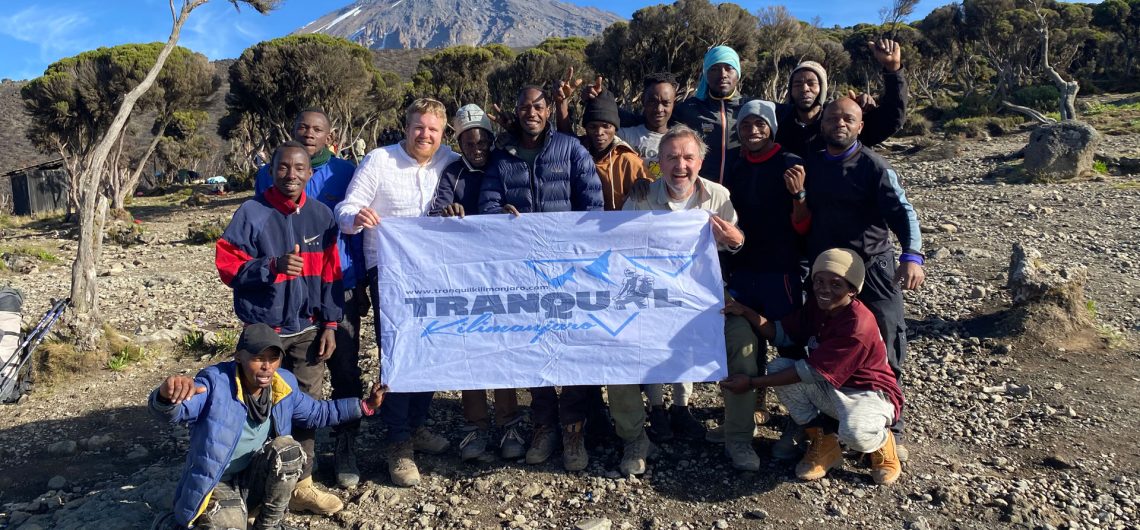Climbing Mount Kilimanjaro at over 50 years old is entirely possible and is a goal that many people in that age group successfully achieve.
From the perspective of an experienced climber, Kilimanjaro offers the ideal challenge. You will have the opportunity to conquer one of the seven summits during the hike without facing any significant technical difficulties.
For climbers over 50 who are interested in a slower-paced journey, we can develop a unique route that will allow them to fully experience the experience. Mount Kilimanjaro offers one of the most picturesque routes on the mountain, giving you plenty of time to acclimatize.
We simply take longer. Just to be clear, those over 50 have the same chance of reaching the top of Kilimanjaro as those who have not yet turned 50. Yes, possibly even more so.
However, older climbers on Kilimanjaro perform differently from their younger contemporaries.
For starters, climbers over the age of 50 typically take longer to reach the summit. This is not a problem because there will be one guide for every two climbers as long as the organization that organized the expedition complies with the regulations. As a result, anyone who is falling behind the group can always hike with a qualified guide.

1. Fitness and Endurance:
Climbing Kilimanjaro is a demanding endeavor that requires good fitness and endurance. The ascent involves gaining significant altitude, and the higher you go, the more challenging it becomes due to reduced oxygen levels. Before attempting the climb, ensure you have the physical capabilities to handle the rigors of the trek.
2. Ability to Hike in the Dark:
Summit day on Kilimanjaro usually begins at midnight, and climbers hike in darkness using headlamps. Ensure your eyesight and depth perception are suitable for hiking under these conditions.
3. Training and Prior Experience:
If you haven’t done a tough multiday trek before, consider taking on a smaller mountain climb as preparation. Training on routes like Mt. Meru can provide valuable experience and help gauge your suitability for Kilimanjaro.
4. Knees and Descent:
The downhill descent on Kilimanjaro can be challenging on the knees. Trekking poles are essential and can ease the strain on your joints during the descent.
5. Health Considerations:
Discuss your medical condition with your doctor to ensure you’re physically capable of the climb. If you have preexisting medical issues, consult with your physician and assess their potential impact on the trek.
6. Choosing the Right Route:
Opt for longer and more gentle routes like the Lemosho or Northern Circuit to improve your chances of summiting. Longer routes provide better acclimatization and are less strenuous on a daily basis.
7. Travel Insurance:
Comprehensive medical insurance covering climbs up to 6,000 meters is essential. Kilimanjaro tour operators require proof of insurance before allowing climbers to embark on the trek.
Here are notable people that have climbed Kilimanjaro over the age of 50 years.
Anne Lorimor, the oldest person to summit Kilimanjaro – Age 89
70 year old pastor shares her experience climbing Kilimanjaro
Great trekking tips for climbers over 50
Climbing Kilimanjaro is an incredible adventure, and with proper preparation and consideration, climbers over 50 can have a safe and rewarding experience reaching the “Roof of Africa.” Age alone should not be a limiting factor for embarking on such an adventure, but there are some considerations to keep in mind to ensure a safe and enjoyable experience:
- Health Check-Up: Before attempting any physically demanding activity, including climbing Kilimanjaro, it is crucial to undergo a thorough health check-up with your healthcare provider. Make sure you are in good overall health and have no medical conditions that could be exacerbated by high-altitude trekking.
- Physical Fitness: Regular physical exercise and training are essential to prepare your body for the demands of the climb. Focus on cardiovascular fitness, strength training, and endurance exercises. Consider consulting with a fitness trainer to develop a suitable training plan.
- Choose the Right Route: Select a route that allows for gradual acclimatization and takes a few more days to summit. Longer routes, such as the Lemosho or Machame routes, are often recommended for older climbers to acclimate better to the altitude.
- Take Your Time: Climbing Kilimanjaro is not a race. It’s important to pace yourself and take enough time to rest and acclimate during the ascent. Slower-paced climbs increase the chances of successful summiting and reduce the risk of altitude sickness.
- Be Prepared: Ensure you have appropriate clothing and gear for varying weather conditions and temperatures. Invest in a good quality sleeping bag and proper trekking boots to keep your feet comfortable during the hike.
- Mental Readiness: Climbing Kilimanjaro is both physically and mentally challenging. Prepare yourself mentally for the trek, and maintain a positive attitude throughout the climb.
- Experienced Guide and Support: Choose a reputable trekking company that provides experienced guides and a well-trained support team. They will offer valuable guidance, monitor your health, and ensure your safety throughout the journey.
- Hydration and Nutrition: Stay well-hydrated and maintain a balanced diet during the climb. Proper nutrition is crucial for maintaining energy levels and supporting your body’s performance at high altitudes.
- Listen to Your Body: Pay attention to how you feel during the trek. If you experience any symptoms of altitude sickness or feel unwell, communicate with your guide, and don’t hesitate to descend if necessary.
Many older climbers have successfully summited Kilimanjaro and found the experience to be incredibly rewarding. With proper preparation, a positive mindset, and the right support, age should not deter you from pursuing this unforgettable adventure.
![]()


Comments